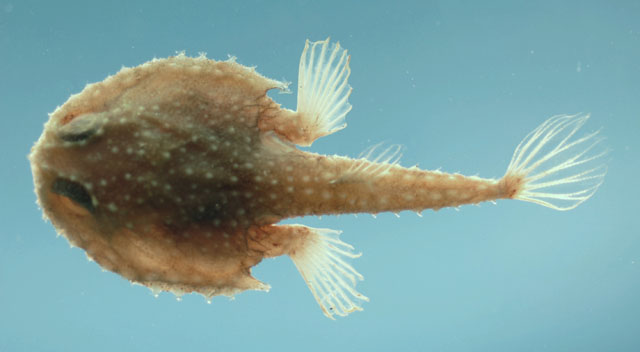| Ogcocephalidae (Batfishes) |
| 39.4 cm TL (male/unsexed) |
|
bathydemersal; marine; depth range 45 - 1300 m |
| Western Atlantic: coasts of Canada and United States, Gulf of Mexico, Caribbean, and the coast of South America to Rio de Janeiro, Brazil; in the east, from the Gulf of Guinea to Angola. |
|
Dorsal spines (total): 0-0; Dorsal soft rays (total): 5-7; Anal spines: 0-0; Anal soft rays: 4-4; Vertebrae: 18-19. Tubercles (its form of scales) have ridges radiating from the apical spine; these ridges heavily edged with spinules, especially the largest tubercles; thus, tubercles appear to be multi-spined. Vertebral count usually 18. Cephalic lateral-line counts: subopercular 4-6, preopercular, 1-3. Tail lateral-line counts 9-13. Usual number of dorsal fin rays 6, pectoral fin rays 14-15; vertebrae 18. Color differences observed between eastern and western Atlantic populations; specimens from Gulf of Guinea often have reticulate markings on the dorsal surface of the body, usually vague (occasionally strong), which are not seen in western Atlantic material. Fins, except dorsal, usually have tubercles on bases of rays. Pectoral fins slender, sturdy relative to most other species; pelvic fins slender (Ref. 40826). |
| Found on mud or sand-mud bottoms (Ref. 26999). Benthic adults are luminous (Ref. 40826). Feeds chiefly on polychaetes; bottom-living amphipods, bivalve molluscs, brittle stars, starfishes and sea spiders (Ref. 5951). |
|
Least Concern (LC); Date assessed: 09 May 2013 Ref. (130435)
|
| harmless |
|
Source and more info: www.fishbase.org. For personal, classroom, and other internal use only. Not for publication.

